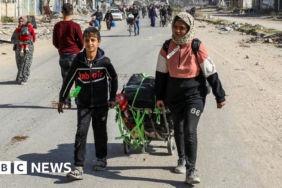Kaynak: www.theguardian.com
Nina Marchenko was in her kitchen when a bomb fell on her cottage. It blew off the roof, demolished the concrete summer house in the garden, and killed her dog, Tulik. Bits of fence were tossed into the air. “There was smoke and that was it,” she said. “A woman died in another strike nearby. I can only curse Vladimir Putin. He’s driven us from our house.”
Last week, Marchenko and her disabled husband, Misha, fled their home in Kupiansk, in the north-east of Ukraine. The Russian army seized the city in the early days of Putin’s 2022 invasion. Ukrainian soldiers took it back eight months later. For most of the last two years the frontline – across the Oskil River and a series of rustic hamlets – barely changed.
In recent weeks, however, the Russians have been advancing. Across the frontline, Ukrainian defences are crumbling at the fastest rate since 2022. In October, Russia swallowed nearly 310 miles (500km) of Ukrainian territory including more than 15 sq miles around Kupiansk. Two-thirds of these losses of territory have been in the neighbouring Donetsk region. Ukraine’s southern sector there is close to collapse.
Russian combat units are now less than two miles from Kupiansk. A little to the south, troops have already reached the Oskil River, turning Ukrainian-controlled territory on the left bank into two separate and shrinking bulges. Bridges across the river are relentlessly bombed. Moscow’s apparent plan is to flatten Kupiansk and then reoccupy it.
Speaking from an office bunker, Kupiansk’s military-civilian mayor, Andriy Besedin, described the situation on the eastern side of the Oskil as “critical”. He said 1,400 people were refusing to evacuate from their homes, despite having no electricity, water or gas. Most were elderly people. They were not pro-Russian, Besedin suggested, but simply unwilling to move out or listen to anxious relatives.
“We are going flat to flat and driving around with loudspeakers. We say: ‘Please leave. We don’t know what will happen tomorrow,’” he said. “The pensioners think the Russians won’t hurt them. We tell them the situation is different from 2022 and that they will get killed.”
“I hope when the weather changes and it’s cold they will finally exit,” Besedin added.
Since the beginning of October the situation in Kupiansk became dramatically worse, the mayor said. Russian kamikaze drones were flying above the city, targeting people waiting at bus stops. “We can’t deliver humanitarian aid. They see a pick-up and hit it with a drone. You can’t outrun them,” Besedin said. About 2,200 residents remained, as missiles crashed around them.
Recently a Russian warplane dropped a 1,500kg guided bomb on the civic building next to Besedin’s office, killing three people. The decorative brick structure was a sprawling mess. Was the Kremlin trying to target the mayor personally? “Yes,” Besedin said. “They’ve tried several times.” Other missiles have struck Kupiansk’s museum, football ground, meat factory, market and palace of culture.
Ukraine was battling against terrorism and dictatorship, Besedin said, and a malevolent axis of countries that included Russia, North Korea and Iran.
“Our guys are fighting for every centimetre. Unfortunately the civilised world isn’t giving us enough weapons. What about democratic values? Stopping Russia is our collective responsibility. If we fail, Putin will attack the Baltic states and Poland,” he said.
Soldiers said conditions on the frontline were tough. “We don’t have enough to shoot with. They fire 10 shells for our one,” said Oleksandr Isaiev, a 59-year-old sapper. The Russians had more personnel and armoured vehicles, he said, and dropped between eight and 12 KAB glided bombs a day on his position. “If one lands on you, you’re dead. They make a hole 5 metres deep and 10 metres’ across,” he said.
Isaiev expressed frustration at the west’s so-called “red lines” and the Biden administration’s persistent refusal to allow Kyiv to hit targets deep inside Russia with US-supplied munitions. The UK and France have not lifted restrictions either. “We have the rockets. But we can’t use them to wallop Russian airfields,” Isaiev said. “Until the US gets over its nervousness, we will lose territory.”
after newsletter promotion
With too few conventional weapons, Ukraine is trying to hold the line using drones. Oleksandr Ivantsov, a drone operator with the 3rd Assault Brigade, said the situation on the left bank was tense. The Russians were constantly trying to storm Ukrainian positions, he said, adding: “There are battles everywhere. Sometimes they succeed. Sometimes they don’t. There are no easy places. They have huge resources.”
This week, streets in Kupiansk were largely deserted. A handful of elderly residents could be seen carrying shopping bags and pushing trolleys. Police on patrol wore body armour. Besedin said he would provide municipal services for as long as possible. “We are fighting on every front: military, administrative and social,” he said. “Everybody is doing what they can. Kupiansk isn’t lost yet.”
Some residents, however, acknowledged it was only a matter of time before the Russians came back. Ksenia Lukyanova said her home city was strategically important and a railway hub. From Kupiansk, a road went south to the town of Izium – occupied and liberated in 2022 – and the garrison city of Sloviansk. Another led to Kharkiv, Ukraine’s second city. To the north was the Russian province of Belgorod.
“During the second world war, Kupiansk was seized and liberated four times. It switched between Soviets and Nazis,” Lukyanova said. Last year a bomb wrecked her home. In September, shrapnel shattered the window of her new apartment in the village of Hrushivka, just outside Kupiansk. “We carry on, keep smiling and try and help each other. Inside we are crying and screaming,” she said. “Our souls hurt.”
Her friend Natalya Surko said most residents in the suburb of Kupiansk-Vuzlovyi were packing up to leave. “At night it’s terrible. You hear a siren and three seconds later an explosion. There’s no time to get dressed. After the first bang, you think: ‘Do I get up or not?’ You don’t.” Surko said she lost her job as Kupiansk’s railway station duty manager when the full-scale war arrived. “I’m paid £40 a month,” she said.
Evacuees from the Kupiansk region are taken to a processing centre in Kharkiv, where they are registered and given medical checkups. Some arrive in their own vehicles; others are brought by minibus or ambulance. So far this month 1,800 people have turned up. Local charities, the UNHCR and the Red Cross dole out emergency parcels. Many of the displaced stay with relatives. Others are allocated dormitories.
The regional administration had issued compulsory evacuation notices to families with children. Lilya Shevchenko, 16, and Nadia Shynkarenko, 14, said they had come from Barove, a left-bank village south of Kupiansk. Every other house was smashed, they said. “The Russians were 30kms away. Now it’s 15 to 20kms. There are a few old ladies left. At night people drive to Izyum and sleep there, because it’s safer,” Lilya said.
She described bombardment as scary but said Russia’s eight-month occupation in 2022 was far worse. “For the first few weeks we had no internet connection. We didn’t know what was happening in Kharkiv. The Russians stole everything. They were drunk. We were afraid to go out on the street.” She last attended school on the day before the invasion, and was studying online, she said.
Queuing up to register, Marchenko said she had left all her belongings behind. “We had a garden with fruit trees and vegetables. But this year it was only weeds because it was impossible to plant anything. As soon as you stepped foot outside they start to shell,” the 72-year-old said. Would she ever go back? “I don’t know. If my house still stands, maybe I will.”






Yorumlar kapalı.